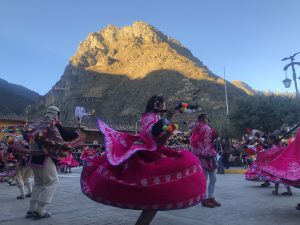Helen’s trip to Perú!
Greetings! My name is Helen Johnston, and I’m a sophomore from… It’s a bit complicated. I grew up in Chicago, Illinois and moved to Park City, Utah when I was ten. My dad stayed in Chicago, so I flipped back and forth between the two states until I was fourteen, when I went to boarding school in Culver, Indiana. So you can take your pick of where I’m from! I’m planning on majoring in Economics* and Global Studies, and hoping to create my own minor in Arts Administration.
(*I am four weeks into Economics 410 and completely lost, so the likelihood that this major will change is extremely high. Stay tuned!)

This past summer, I had the chance to intern in Ollantaytambo, Peru for Awamaki, a non-profit that connects indigenous artisan weavers to an international market, as well as working to financially empowering local women.
My arrival in Peru left no time for rest and relaxation. June 8th marked the start of ChoqueKillka, a festival that displays the syncretic nature of modern-day Peru. I was surprised to see the beautiful harmony in which the Peruvians mixed the indigenous Quechua religion of the Incans and the Christian religion of the conquistadors. ChoqueKillka, a four-day festival, features 17 dances and a cargo is held for each one. A cargo is a party within the festival hosted by a local Ollantian family featuring live music, heaps of steaming food, and lots of salsa.

Despite ChoqueKillka making my arrival a bit hectic, things began to settle down. Our office space was in an old hostel, and I frequently worked in the courtyard, where I had an incredible view of Incan ruins. Aside from the incredible view, my favorite part of the work was traveling to the inidgenous communities, where we would meet and work with the local female artisans. Backstrap weaving has been a tradition in Peru for hundreds of years. Quechua, the indigenous Incan language, was originally oral, so weaving was how Incans would record histories, thoughts, and feelings.

The tradition was well retained. Young girls are taught as young as six how to operate a pushka, a device that allows raw alpaca and sheep wool to be combined into a single piece of thread. Females are then taught to weave around 10 years of age, and become extremely talented within months. Projects, such as weaving a blanket, can take over a year and require incredible precision and finger dexterity.
One of my favorite stories from the trip was when I was in Hullioc, a rural community that rests at around 12,000 feet. Breathless, my fellow volunteers and I hurried after the artisans who would be leading our weaving workshops. They flew down the steep, rocky mountain side in skirts and rubber sandals, spinning their pushkas, and still somehow managing to offer a free hand to my companions and I as we inched our way down the mountain in hiking books and athletic gear. Getting to our final destination, the artisans set up the weaving stations and began to instruct. About two hours into the lesson, after my instructor had been laboring over her loom for the entire time, a baby started to cry. I looked around the field, but didn’t see anyone with a baby. All of a sudden my instructor sat up, shifted the (what I thought to be a bundle of clothes wrapped in beautiful cloth) on her back, and a baby’s smiling face popped out. The baby’s smiling face reminded me of the incredible strength of these women who can be expert artisans, instructors, adventure guides, and mothers all at once. I am extremely moved by these awe-inspiring women, hope to work with them in the future!
